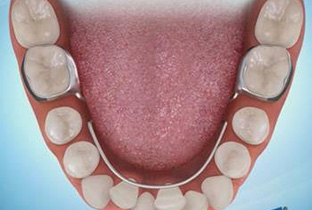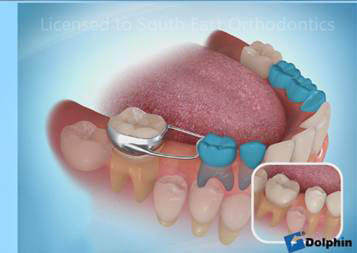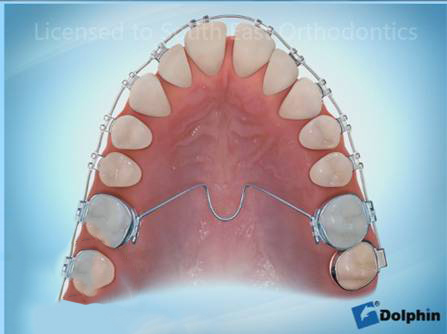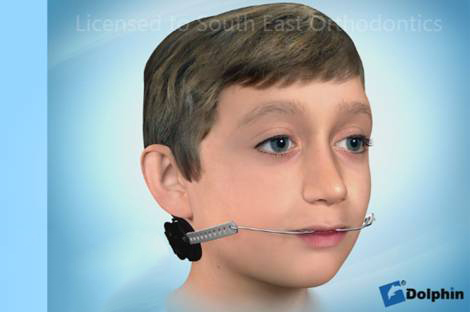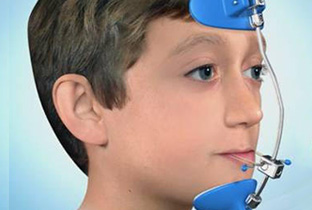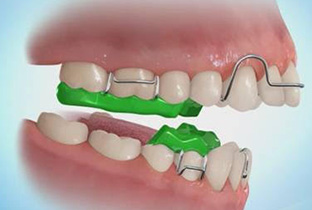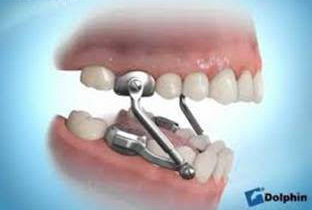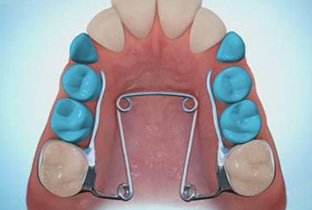Frequently Asked Questions
A lingual arch is a type of dental appliance that is commonly used in orthodontics to maintain space in the dental arch and prevent unwanted movement of teeth. It consists of a wire that is attached to the lingual (tongue) side of the lower or upper teeth, and it spans across the dental arch. The wire is typically made of stainless steel, but it can also be made of other materials such as nickel-titanium or titanium-molybdenum.
Lingual arches are often used in cases where a patient has lost one or more baby teeth prematurely or has a significant amount of space between their teeth. The appliance can help prevent the surrounding teeth from drifting into the space and can also create enough room for permanent teeth to erupt properly.
Lingual arches are typically adjusted periodically by an orthodontist to ensure that they continue to maintain the correct amount of space in the dental arch. They are often used in conjunction with other orthodontic appliances, such as braces or aligners, to achieve optimal tooth alignment and bite correction.
The Herbst appliance is a type of orthodontic appliance that is used to correct overbite, a condition where the upper teeth significantly overlap the lower teeth. It is named after its inventor, Dr. Emil Herbst.
The Herbst appliance is typically used in cases where the overbite is caused by a discrepancy between the size of the upper and lower jaws. The appliance consists of metal rods that are attached to bands placed on the upper and lower molars. The rods are designed to hold the lower jaw forward in a more natural position, which can help reduce the overbite.
The Herbst appliance is typically worn for 9–12 months and it is adjusted periodically by an orthodontist to ensure that the jaw is being moved in the correct direction. Patients may experience some discomfort or difficulty speaking and eating during the first few days after the appliance is placed, but these side effects usually subside quickly.
One of the advantages of the Herbst appliance is that it can help correct the overbite without requiring the patient to wear headgear. It can also be used in conjunction with other orthodontic appliances, such as braces or aligners, to achieve optimal bite correction and tooth alignment.
As with any orthodontic treatment, the use of the Herbst appliance requires careful monitoring by an orthodontist to ensure that the treatment is progressing as planned and to address any issues that may arise.
A Herbst appliance is typically recommended for children and adolescents with a Class II malocclusion, commonly known as an overbite. This condition involves the upper jaw and teeth significantly overlapping the lower jaw and teeth. The Herbst appliance helps correct this by encouraging the lower jaw to grow forward while restraining the growth of the upper jaw, thereby improving the alignment of the jaws and teeth. Orthodontists often use this appliance for patients who have a significant overbite that cannot be corrected with braces alone, are in their growth spurts (typically between the ages of 9 and 14), and require an alternative to headgear for overbite correction. The appliance is most effective when used during the patient’s growth period, making it an ideal choice for young patients whose jaws are still developing.
A Quad helix is a type of dental appliance used in orthodontics to correct dental malocclusions (improper bites) by expanding the width of the upper dental arch. It is also known as a palatal expander or a rapid maxillary expander.
The Quad helix appliance consists of a small metal framework that is custom-made to fit the roof of the mouth. The framework has four arms that extend towards the back of the mouth and are attached to the molars on each side. The appliance is anchored in place by small bands that are cemented to the molars.
The Quad helix appliance works by applying gentle pressure to the teeth and the bones of the upper jaw. This pressure causes the bones to gradually separate and expand, creating additional space for the teeth to move into proper alignment. The Quad helix can also help to correct crossbites, where the upper teeth sit inside the lower teeth, by widening the upper arch to align with the lower teeth.
The Quad helix is typically adjusted by an orthodontist every few weeks to gradually increase the amount of expansion. The appliance is usually worn for several months until the desired amount of expansion is achieved. After the appliance is removed, patients will often wear a retainer to maintain the expansion and prevent the teeth from shifting back to their original position.
Yes, a quad helix expander can cause a gap between the front teeth, particularly the upper central incisors. This occurs because the expander widens the upper arch, creating space for crowded teeth. As the arch expands, the teeth are pushed apart, resulting in a temporary gap. This gap is usually a normal part of the treatment process and often closes on its own as the orthodontic treatment progresses and the teeth are guided into their proper positions.
The benefits of early orthodontic treatment:
1. Improved oral health: Early treatment reduces the risk of dental problems, such as tooth decay and gum disease, by addressing dental and skeletal issues promptly.
2. Prevention of complications: Early intervention prevents complex conditions and invasive treatments in the future, saving time and discomfort for the child.
3. Enhanced facial aesthetics: Correcting alignment issues early on improves the child’s smile and facial appearance, boosting self-esteem.
4. Optimal jaw growth: Early treatment guides proper jaw development, leading to improved oral function, speech, and facial symmetry.
5. Reduced treatment time: Addressing issues early may result in shorter overall treatment times and less extensive treatment in the future.
6. Improved bite and function: Early treatment corrects malocclusions, improving bite alignment, chewing, and speaking abilities.
7. Habit management: Early intervention helps correct harmful habits, preventing potential complications related to dental development.
Remember that the benefits can vary depending on the individual case, and consulting an orthodontist or dentist specialising in paediatric orthodontics is important for personalised assessment.
An orthodontic emergency typically involves issues that require immediate attention to prevent discomfort, potential damage to braces, or disruption to treatment progress. Examples include severe pain or swelling, a broken bracket or wire that causes irritation or injury to the mouth, and any situation that affects the ability to eat or speak comfortably. It’s important to contact your orthodontist promptly if you experience any of these issues.
Early orthodontic treatment is necessary for several reasons. It allows orthodontists to address issues before they worsen, preventing complex conditions and invasive treatments later. It guides dental development, creating space for permanent teeth and reducing the need for extractions. It corrects malocclusions and improves the bite during childhood when the jaws are developing. It can influence jaw growth, enhance the facial profile, and prevent future complications. It also manages harmful oral habits that can impact dental development. Overall, early treatment optimises oral health, aesthetics, and self-confidence.
Early orthodontic treatment for children, also known as interceptive orthodontics or Phase 1 orthodontic treatment, aims to correct dental and skeletal issues in children between 6 and 10 years old. It addresses problems such as improper bites, crowded or misaligned teeth, and jaw growth imbalances. Treatment involves using orthodontic appliances like braces, expanders, or removable appliances. The duration varies, and follow-up care is needed until all permanent teeth have erupted. Assessment by a qualified orthodontist or dentist is crucial to determine if early treatment is necessary.
A quad helix expander is typically used for children and adolescents, usually between the ages of 6 and 16. This age range is ideal because the jaw is still growing and more malleable, making it easier to expand the upper arch and correct issues such as crossbites, crowded teeth, and narrow palates. The exact timing for using a quad helix expander can vary based on individual dental development and the specific orthodontic issues being addressed.
Early orthodontic treatment can potentially affect a child’s speech, particularly if the treatment involves appliances that alter the position of the teeth or jaws. For instance, devices like expanders or retainers might cause temporary changes in speech patterns as the child adjusts to the appliance. However, most children adapt quickly, and any speech issues are usually short-lived. Regular follow-up appointments with the orthodontist can help monitor and address any speech concerns that arise during treatment.
Using traditional teeth whitening products, like strips or trays, can be challenging while wearing braces. The brackets and wires create obstacles that can prevent even the application of the whitening agents across all teeth surfaces, potentially leading to uneven whitening results. Additionally, the bleaching agents in these products may not be compatible with the materials used in braces, risking damage or discolouration. It’s advisable to consult your orthodontist before using any teeth whitening products to ensure they are safe and suitable for your specific orthodontic treatment plan. Your orthodontist may recommend alternative whitening options or advise waiting until after your braces are removed for optimal and uniform teeth whitening results.
Several signs might indicate that a child could benefit from early orthodontic treatment:
- Crowded or Crooked Teeth: If a child’s teeth are crowded or crooked, early intervention can help guide proper alignment.
- Bite Issues: Issues such as overbites, underbites, or crossbites can be identified and addressed early to prevent more severe problems later.
- Difficulty Chewing or Biting: If a child has trouble chewing or biting properly, it may be a sign of alignment or bite issues.
- Mouth Breathing: Consistent mouth breathing instead of nasal breathing can indicate structural issues that might require orthodontic treatment.
- Early or Late Loss of Baby Teeth: Losing baby teeth too early or too late can affect the alignment of incoming permanent teeth, making early treatment beneficial.
If you notice any of these signs, it’s a good idea to consult with South East Orthodontics for a thorough evaluation and personalised treatment plan.
When choosing the right orthodontist for your child’s early treatment, consider the following factors:
- Qualifications and Experience: Ensure the orthodontist is a certified specialist with extensive experience in early orthodontic treatment. Check their credentials and professional background.
- Reputation and Reviews: Look for recommendations from your child’s dentist or other parents. Online reviews and testimonials can provide insights into the orthodontist’s success with early treatments.
- Treatment Options: Verify that the orthodontist offers a range of early intervention treatments and uses up-to-date technology.
- Communication: Choose an orthodontist who communicates clearly and makes both you and your child feel comfortable. They should explain treatment options, and expected outcomes, and address any concerns.
Office Environment: Visit the orthodontic office to assess the environment. A welcoming, clean, and child-friendly office can make a big difference in your child’s experience.
If you experience a dental emergency related to your braces outside of regular office hours, start by assessing the severity of the issue. For minor discomfort or issues like a loose bracket or wire, you can use orthodontic wax to alleviate discomfort temporarily. Avoid chewing on hard or sticky foods that could further damage your braces. If the problem is severe, such as significant pain, injury to the mouth, or a broken appliance, contact your orthodontist immediately. Most practices have emergency contact numbers or instructions for handling urgent orthodontic issues after hours.
Start the Conversation
Do you want straight teeth?

Ask a Question or
Book an appointment
Please fill in the online enquiry form to ask a question or book an appointment.
Or call today on

